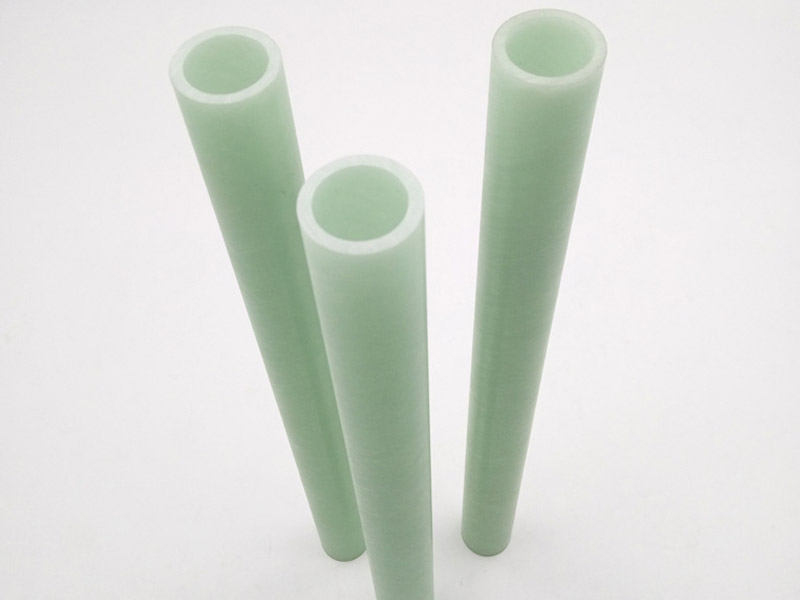Epoxy fiberglass tube is a kind of insulating pipe with high insulation performance, which is made or wound with glass fiber material and epoxy resin film. The main winding processes include the following:
(1) Dry winding. The fiber is dipped into a prepreg tape (the resin is in
the B stage), heated to soften, wound on the core mold and cured.
The characteristics are: strict control of the glue content, uniform and stable product quality; the winding speed can be increased to 100~200m/min during the process; the equipment and the site are relatively clean during the molding process; the automation and mechanization are easy to achieve; the labor and hygiene conditions are good, and the product High quality; it is required that the curing agent used does not sublime or volatilize during the drying of the prepreg, and does not deteriorate during intermediate storage. The winding equipment is more complicated, and prepreg yarn manufacturing equipment needs to be added, so the investment is relatively large, and the product layer-wise shear strength is low.
(2) Wet winding. After the fiber is dipped in glue, it is directly wound on the core mold and cured.
It is characterized by simple equipment and 40% lower cost than dry winding; the product has good air tightness, because the tension during winding causes excess glue to squeeze out bubbles; the glue on the fiber during winding can reduce fiber wear; high production efficiency (Up to 200m/min). However, the waste of resin glue is large, the working environment is poor, and the glue content is not easy to control, which affects the quality of the finished product. Due to the low investment and low cost (about 60% of dry production), there are more domestic applications, mainly for the production of civilian products and electrical products.
(3) Semi-dry winding. Compared with the wet method, it increases the
drying process, that is, the drying facility is added between the fiber dipping
and winding to the core, which is convenient to remove the volatile low
molecular weight in the dipping rubber, reduce the air gap of the finished
product, and improve the quality of the product. The process of winding and
heating and softening of prepreg and the corresponding equipment are reduced,
which not only improves production efficiency but also improves product
quality.

Features:
1. Good corrosion resistance. Since the main raw materials of glass fiber reinforced plastic are composed of polymer unsaturated polyester resin and glass fiber, it can effectively resist the corrosion of acid, alkali, salt and other media and untreated domestic sewage, corrosive soil, chemical wastewater and many chemical liquids. The erosion, in general, can maintain safe operation for a long time.
2. Good aging resistance and heat resistance. The epoxy glass fiber tube can be used for a long time in the temperature range of -40℃~70℃, and the high temperature resistant resin with special formula can also work normally at temperatures above 200℃.
3. Good frost resistance. Below minus 20℃, the tube will not freeze and crack after freezing.
4, light weight, high strength. The relative density is between 1.5 and 2.0, only 1/4 to 1/5 of that of carbon steel, but the tensile strength is close to or even higher than that of carbon steel, and the specific strength can be compared with that of high-grade alloy steel. Therefore, it is effective in aviation, rockets, space vehicles, high-pressure vessels, and other products that need to reduce their own weight.
5. Good designability. Various structural products can be flexibly designed to meet the requirements of use, and the product can have a good integrity.
6. Good abrasion resistance. Put water containing a large amount of mud and sand into the pipe to conduct a comparative test of the effects of rotating wear. After 3 million rotations, the wear depth of the inner wall of the inspection tube is as follows: steel pipe coated with tar and enamel is 0.53mm, steel pipe coated with epoxy resin and tar is 0.52mm, and surface hardened steel pipe is glass steel pipe It is 0.21mm. Therefore, FRP has good wear resistance.
7. Good electrical and thermal insulation. FRP is a non-conductor. The electrical insulation of the pipeline is excellent. The insulation resistance is 1012-1015Ω.cm. It is most suitable for use in power transmission, telecommunications line dense areas and mine areas. The heat transfer coefficient of FRP is very small, only 0.23, which is 1000 Fifth, the pipeline has excellent insulation performance.